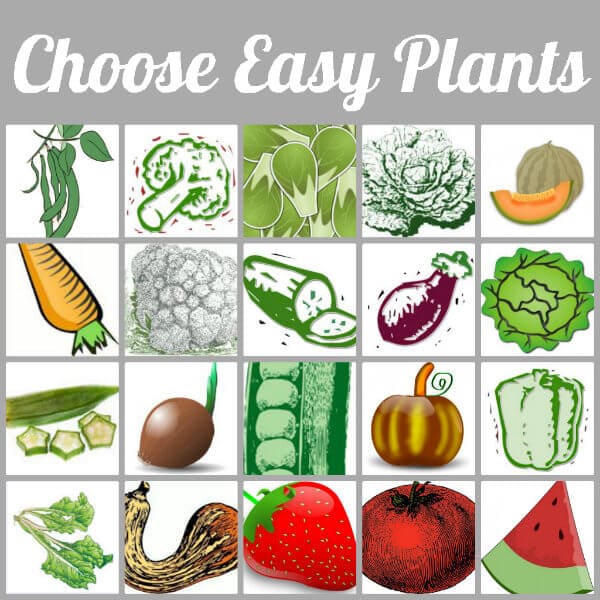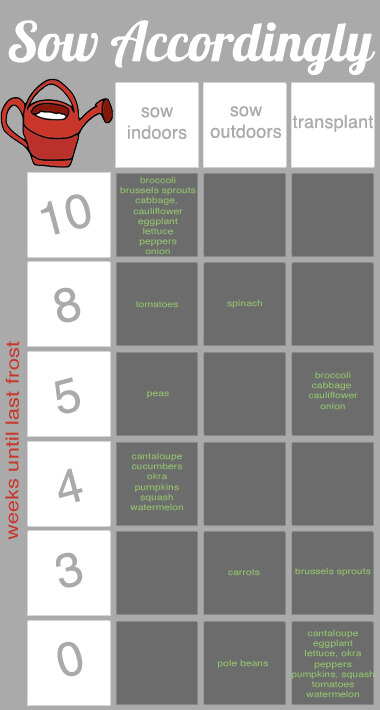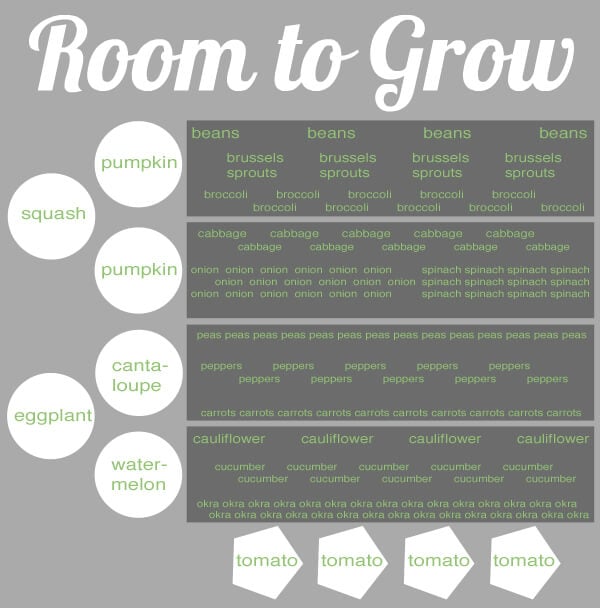I already our spring garden preparation methods with you all, and now it's time to share the actual step-by-step of how to plant a spring garden! If you've already researched how to plant a spring garden and have been totally confused about “zones,” just ignore the whole zone thing for now. Zones are a fancy way of talking about how hot or cold your area gets and which plants grow best where you are. All of the plants below will work for pretty much every zone (provided you have a planting space that gets at least six hours of light per day), and we've broken it all down into a simple step-by-step guide for how to plant a spring garden.
How to Plant a Spring Garden
How to Plant a Spring Garden Step 1: Order seeds
We like to start most of our plants from seeds because we have full control over organic growing methods that way, and it's a whole heck of a lot cheaper than buying pre-started plants at the store. The downside to this is that you have to begin growing the plants indoors quite early in the season, and you'll need at least a couple feet of counter space in your home to work on. If you're getting a late start or simply want to skip the whole seed thing and start with pre-started plants, just go by the “sow outdoors” and “transplant” dates on the how to plant a spring garden calendar below. You'll want a variety of fruit and vegetables that your family likes to eat. We order from FedCo seeds, a co-op out of Maine that sells hardy seeds at great prices. Here's our order for this season:
282 – Fortex Pole Bean OG ( A=1/2oz) 1 x $1.80 = $1.80
760 – Green Arrow Shell Pea ( A=2oz) 1 x $1.30 = $1.30
984 – Sunsweet Watermelon ( A=1/16oz) 1 x $1.60 = $1.60
1312 – Marketmore 76 Slicing Cucumber ( A=1/16oz) 1 x $0.90 = $0.90
1402 – Eight Ball Zucchini ( A=1/8oz) 1 x $2.00 = $2.00
1615 – Squisito Winter Squash ( A=1/8oz) 1 x $1.60 = $1.60
1713 – Lumina Pumpkin ( A=1/8oz) 1 x $1.60 = $1.60
1719 – New England Pie Pumpkin ( A=1/4oz) 1 x $0.80 = $0.80
2051 – Nantes Fancy Carrot OG ( A=1/8oz) 1 x $2.00 = $2.00
2444 – Crystal White Wax Onion ( A=1/16oz) 1 x $1.30 = $1.30
2447 – Whitewing Onion ( A=1/16oz) 1 x $1.70 = $1.70
2488 – Varsity Onion ( A=1/16oz) 1 x $1.90 = $1.90
2491 – Redwing Onion ( A=1/16oz) 1 x $2.30 = $2.30
2510 – Space Spinach ( A=1/4oz) 1 x $1.20 = $1.20
2550 – Tyee Spinach ( A=1/4oz) 1 x $1.20 = $1.20
2761 – Red Sails Lettuce OG ( A=2g) 1 x $1.60 = $1.60
2811 – Buttercrunch Lettuce ( A=2g) 1 x $0.70 = $0.70
3311 – Green King Broccoli ( A=0.5g) 1 x $1.50 = $1.50
3339 – Gustus Brussels Sprouts ( A=0.5g) 1 x $2.50 = $2.50
3355 – Early Jersey Wakefield Cabbage ( A=2g) 1 x $0.80 = $0.80
3410 – Snow Crown Cauliflower ( A=0.5g) 1 x $1.90 = $1.90
3685 – Black King Eggplant ( A=0.2g) 1 x $1.50 = $1.50
3699 – Becks Big Buck Okra OG ( A=2g) 1 x $1.20 = $1.20
3728 – Staddons Select Sweet Pepper OG ( A=0.5g) 1 x $1.20 = $1.20
3777 – Anaheim Hot Pepper ( A=0.5g) 1 x $0.80 = $0.80
4207 – Juliet Tomato ( A=0.2g) 1 x $2.70 = $2.70
4211 – Premio Tomato ( A=0.1g) 1 x $2.30 = $2.30
4218 – Bobcat Tomato ( A=0.1g) 1 x $2.50 = $2.50
4233 – Jet Star Tomato ( A=0.2g) 1 x $2.20 = $2.20
We're buying cantaloupe seeds and may also add in some strawberry starter plants from our local nursery (these are both best when sourced locally). You'll want to start seeds indoors (we use toilet paper roll seed starters) according to the planting calendar below, and slowly adjust them to the outdoors by bringing your seed-starting containers outside in a protected area and slowly exposing them over a period of two weeks before planting them in the ground.
How to Plant a Spring Garden Step 2: Create a planting calendar
It is important to know when the last spring frost date is for your area. Many plants need to be planted after the last frost, so that they don't freeze their little buds off (heh heh). Look up the last spring frost date for your area on Victory Seeds, and then follow the how to plant a spring garden guide below.
- Ten weeks before last frost
- Sow indoors: broccoli, brussels sprouts, cabbage, cauliflower, eggplant, lettuce, peppers, onion
- Eight weeks before last frost
- Sow indoors: tomatoes
- Sow outdoors: spinach
- Five weeks before last frost
- Sow outdoors: peas
- Transplant: broccoli, cabbage , cauliflower, onion
- Four weeks before last frost
- Sow indoors: cantaloupe, cucumbers, okra, pumpkins, squash, watermelon
- Three weeks before last frost
- Sow outdoors: carrots
- Transplant: brussels sprouts
- Week of last frost
- Sow outdoors: pole beans
- Transplant: cantaloupe, eggplant, lettuce, okra, peppers, pumpkins, squash, tomatoes, watermelon
How to Plant a Spring Garden Step 3: Make a garden layout plan
We have four separate gardening spaces that are each about three feet by twelve feet, so we break our garden out into four sections. No matter you lay your garden out, some plants need more space than others and plants all grow better when grouped with certain other plants. Follow the how to plant a spring garden guidelines below, more or less. And in case you can't tell from our lovely graphics above, those circles are where we're separating the large plants out into their own growing space using old tires (any spacing method will work for these big plants – you can even just plant them on large mounds of dirt – as long as you're sure to give those big ones plenty of room to stretch out). We'll probably use a tomato cage or trellis for these large vining plants and for the cucumbers as well, since they have a tendency to kind of take over. With a little encouragement, they grow UP instead of OUT and all over the place. eHow has an excellent article about using cages and trellises for vining plants – you can even just create a big circle of chicken wire for them to grow up, and it'll serve double-duty by helping keep critters out of the plant. The hexagons are separate pots we're using for the tomato plants. Almost all of these plants do best in full sun, which is defined as a minimum of six hours of sunlight per day.
- Group one
- Beans: 3″ apart, 2″ deep – full sun
- Brussels sprouts: 18″ apart, 1″ deep – full sun or partial shade
- Broccoli: 12″ apart, 1″ deep – full sun or partial shade
- Group two
- Onions: 4″ apart, 1″ deep – full sun or partial shade
- Lettuce: 8″ apart, 1/2″ deep – partial shade
- Cabbage: 12″ apart, 1″ deep – full sun or partial shade
- Spinach: 3-5″ apart, 3/4″ deep – partial shade
- Group three
- Peas: 2″ apart, 2″ deep – full sun or partial shade
- Carrots: 3″ apart, 1/2″ deep – full sun or partial shade
- Peppers: 12″ apart, 1/2″ deep – full sun
- Group four
- Cauliflower: 18″ apart, 1″ deep – full sun or partial shade
- Cucumbers: 12″ apart, 1/2″ deep
- Okra: 6″ apart, 2″ deep – full sun
- Tire Planting
- Pumpkins: 36″ apart, 2″ deep – full sun
- Watermelon: 36″ apart, 2″ deep – full sun
- Cantaloupe: 24″ apart, 2″ deep – full sun
- Squash: 36″ apart, 2″ deep – full sun
- Eggplant: 24″ apart, 1/2″ deep – full sun
- Containers
- Tomatoes: 18-24″container, 1/2″ deep – full sun
And here you have the whole kit and caboodle all laid out for easy reference on how to plant a spring garden. If you click the image above, it will take you to a handy dandy printable guide for how to plant a spring garden.
If we do decide to add strawberries into the mix, they'll be going in a long aerated trough container or baskets so I can give them a little extra care. Strawberries can be a little finicky.
If you don't plan to follow our guide to the tee, what changes will you be making? I'd love to hear your own plan for how to plant a spring garden!




Alright, I’ve never started seeds indoors before, and I’m still pretty new to all this. What if there’s still snow on the ground, when you should be sowing things outdoors, like the spinach? A real possibility it seems here right now. I just bought a house and it has a beauitful garden space I can’t wait to plant in!
Most of these plants are pretty hardy, frost tolerant and even able to withstand snow when planted at the right depth. But I was a little worried about timing, too, since we’ve had a harsher-than-normal winter here. I asked the experts at my nearby feed store and they said that while going by the average frost dates is usually fine, pushing the outdoor planting date back by about a week during this especially cold season isn’t a bad idea. Better to plant a little bit late, rather than a little too early. I definitely suggest finding a local gardener who’s knowledgeable about the climate and specifics of your area – they can offer great direction! I’ve always gotten the best advice from the employees at my local garden store. The big chain home and garden stores around here tend to be too busy for anyone to offer much individual attention.
Do you consider companion planting in your layout?
Yup! Onions pair well with cabbage and spinach, broccoli pairs with brussels sprouts, peppers with carrots, etc. Although I probably shouldn’t have put the pole beans so close to the brussels sprouts. And it’s important to change up the beds every year, not planting the same thing in the same place constantly.